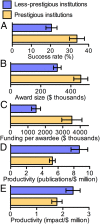Opinion: The National Institutes of Health needs to better balance funding distributions among US institutions
- PMID: 31266906
- PMCID: PMC6613164
- DOI: 10.1073/pnas.1909217116
Opinion: The National Institutes of Health needs to better balance funding distributions among US institutions
Conflict of interest statement
The authors declare no conflict of interest.
Figures


Similar articles
-
Health ROI as a measure of misalignment of biomedical needs and resources.Nat Biotechnol. 2015 Aug;33(8):807-11. doi: 10.1038/nbt.3276. Nat Biotechnol. 2015. PMID: 26252133 Free PMC article. No abstract available.
-
Evaluating the burden of disease and spending the research dollars of the National Institutes of Health.N Engl J Med. 1999 Jun 17;340(24):1914-5. doi: 10.1056/NEJM199906173402411. N Engl J Med. 1999. PMID: 10369857 No abstract available.
-
Successful grants management.Science. 1995 Sep 8;269(5229):1329. doi: 10.1126/science.7660112. Science. 1995. PMID: 7660112 No abstract available.
-
Barriers to conducting clinical research in reproductive medicine: United States of America.Fertil Steril. 2011 Oct;96(4):817-9. doi: 10.1016/j.fertnstert.2011.09.013. Fertil Steril. 2011. PMID: 21961918 Review.
-
National Institutes of Health eliminates funding for national architecture linking primary care research.J Am Board Fam Med. 2007 Mar-Apr;20(2):229-31. doi: 10.3122/jabfm.2007.02.070012. J Am Board Fam Med. 2007. PMID: 17341760 Review.
Cited by
-
Looking back on a life of unacknowledged privilege and a call to action.Mol Biol Cell. 2021 May 15;32(11):1081-1085. doi: 10.1091/mbc.E21-01-0024. Mol Biol Cell. 2021. PMID: 33983852 Free PMC article.
-
Gene-Targeted Therapies in Pediatric Neurology: Challenges and Opportunities in Diagnosis and Delivery.Pediatr Neurol. 2021 Dec;125:53-57. doi: 10.1016/j.pediatrneurol.2021.09.011. Epub 2021 Sep 25. Pediatr Neurol. 2021. PMID: 34628144 Free PMC article.
-
Scientometric analysis of trends in global research on acne treatment.Int J Womens Dermatol. 2023 Jul 28;9(3):e082. doi: 10.1097/JW9.0000000000000082. eCollection 2023 Oct. Int J Womens Dermatol. 2023. PMID: 37521754 Free PMC article.
-
An experimental test of the effects of redacting grant applicant identifiers on peer review outcomes.Elife. 2021 Oct 19;10:e71368. doi: 10.7554/eLife.71368. Elife. 2021. PMID: 34665132 Free PMC article.
-
Analysis of gender representation, authorship inflation, and institutional affiliation in abstract acceptance: a 5-year study.Global Surg Educ. 2023;2(1):37. doi: 10.1007/s44186-023-00105-9. Epub 2023 Feb 18. Global Surg Educ. 2023. PMID: 38013876 Free PMC article.
References
-
- Wahls W. P., High cost of bias: Diminishing marginal returns on NIH grant funding to institutions. bioRxiv:10.1101/367847 (1 January 2018).
MeSH terms
LinkOut - more resources
Full Text Sources

